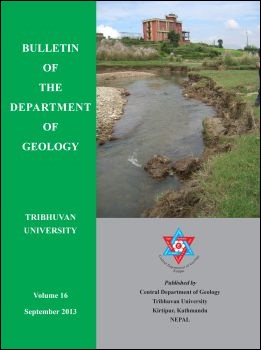Rock Mass Rating and Geological Strength Index of rock masses of Thopal-Malekhu River areas, Central Nepal Lesser Himalaya
DOI:
https://doi.org/10.3126/bdg.v16i0.8882Keywords:
Rock mass characterization, Rock Mass Rating, Geological Strength Index, Malekhu River, Central Nepal Lesser HimalayaAbstract
The rock slopes of the Thopal-Malekhu River areas, Lesser Himalaya, were characterized applying various systems of rock mass classification, such as Rock mass Rating (RMR) and Geological Strength Index (GSI), because the study area comprises well exposed rock formations of the Nawakot and Kathmandu Complexes, across the Thopal-Malekhu River areas. In RMR system, mainly five parameters viz. Uniaxial Compressive Strength (UCS) of rock, Rock Quality Designation (RQD), spacing of discontinuity, condition of discontinuity, and groundwater condition were considered. The new GSI charts, which were suitable for schistose and much disintegrated rock masses, were used to characterize rock slopes based on quantitative analysis of the rock mass structure and surface condition of discontinuities. RMR ranged from 36 to 82 (poor to very good rock mass) and GSI from 13.5±3 to 58±3 (poor to good rock mass). Slates (of the Benighat Slate) are poor rock masses with low strength, very poor RQD, and close to very close spacing of discontinuity, and dolomites (Dhading Dolomite) are fair rocks with disintegrated, poorly interlocked, and heavily broken rock masses yielding very low RMR and GSI values. Phyllites (Dandagaun Phyllite), schist (Robang Formation) and quartzite (Fagfog Quartzite, Robang Formation and Chisapani Quartzite), dolomite (Malekhu Limestone), and metasandstone (Tistung Formation) are fair rock masses with moderate GSI and RMR values, whereas quartzose schist and gneiss (Kulekhani Formation) are very good rock masses having comparatively higher RMR and GSI. The relationship between GSI and RMR shows positive and good degree of correlation.
DOI: http://dx.doi.org/10.3126/bdg.v16i0.8882
Bulletin of the Department of Geology Vol. 16, 2013, pp. 29-42
Downloads
Downloads
Published
How to Cite
Issue
Section
License
© Central Department of Geology, Tribhuvan University, Nepal

